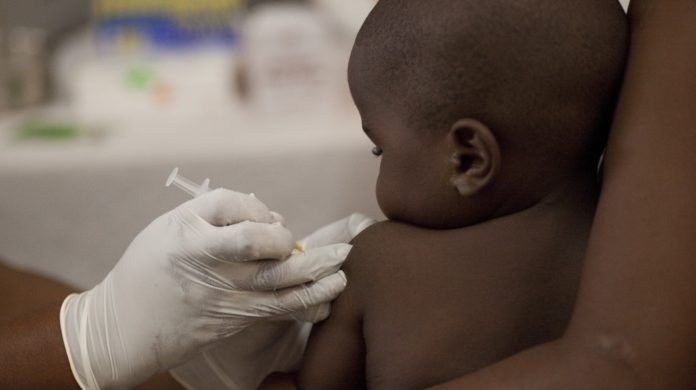
The World Health Organization is calling for renewed collective efforts to get progress on global vaccination targets back on track. Around the world, 1 in 5 children are not receiving routine vaccines that could avert 1.5 million deaths a year from preventable diseases, say the U.N. public health agency.
Dr. Flavia Bustreo, World Health Organization (WHO) assistant director-general for family, women’s and children’s health, says World Immunization Week (April 24th-30th, 2015) is an opportunity for the world to focus on and push harder toward the goal of ensuring every child, “whoever they are and wherever they live,” receives life-saving vaccination.
“It is critical that the global community now makes a collective and cohesive effort to put progress towards our six targets back on track,” she urges.
At the 65th World Health Assembly in Geneva in 2012, 194 countries endorsed the Global Vaccine Action Plan (GVAP) – a roadmap to prevent millions of deaths by 2020 – through “more equitable access to vaccines for people in all communities.” At that meeting, member states also agreed to designate the last week of April as World Immunization Week.
However, a recent independent report on GVAP progress warns that vaccines are not being delivered fairly or reliably and that only one of the six targets for 2015 – the introduction of underutilized vaccines – is currently on track.
65 nations not reaching diphtheria, tetanus and whooping cough vaccination target
One of the at-risk targets for 2015 is to ensure that 90 percent of children receive the DTP3 vaccine to protect against diphtheria, tetanus and whooping cough. Currently, 65 of the 194 countries that signed up to the GVAP are not reaching the target.
While many countries are already vaccinating 4 out of 5 children with DTP3, one third are still struggling to reach the “5th child,” resulting in millions remaining at risk of illness, disability or death. In 2013, nearly 22 million babies did not receive the required three doses of DTP3. Many of these infants live in the world’s poorest nations, according to the WHO.
In May, WHO representatives will be meeting with 34 countries whose DTP3 coverage is currently under 80 percent to discuss barriers to progress and how to overcome them.
Measles, polio, tetanus and rubella vaccination targets also at risk
Another of the at-risk GVAP targets is to eliminate measles from three WHO regions by the end of 2015. The WHO says 16 percent of children are not being immunized against measles and that in the past year, many countries have experienced large measles outbreaks and this has threatened efforts to close this gap.
The other three 2015 GVAP targets that are off-track concern the elimination of polio, maternal and newborn tetanus, and rubella.
Last year, the WHO declared the spread of polio an international public health emergency that threatens to unravel the nearly three-decade effort to eradicate the crippling disease. The unprecedented declaration — the first time the WHO has ever issued an international alert on polio — was released in response to an uptick in polio infections in countries previously free of the disease, such as Syria, Somalia and Iraq, where civil war and unrest now complicate efforts to contain the virus.
Closing the immunization coverage gap
The GVAP outlines three steps for closing the immunization gap:
- Integrate immunization into other health services, such as postnatal care
- Strengthen health systems so vaccines can still be given in times of crisis
- Ensure everyone can access and afford vaccines.
However, Dr. Jean-Marie Okwo-Belé, director for immunization, vaccines and biologicals at WHO, acknowledges that “[t]here is no one centralized approach that can ensure vaccines are delivered and administered to each child.” He says plans on the ground need to adapt not just to countries but also districts and communities.
In their statement, the WHO lists several ways operational needs can adapt on the ground, including: simplify vaccination procedures in the field, improve delivery to reach children living in remote areas, strengthen supply chains and improve quality of data collection and surveillance.
The anti-vax paradox
Meanwhile, as the WHO and other international health agencies work to deliver vaccines to places where millions of children are still dying of preventable diseases, high-income countries like the U.S. — where vaccines are in plentiful supply and most of these diseases have been eradicated — are dealing with a quite different problem.
Having lost sight of the very serious risk that diseases like polio and the measles pose for kids living in vulnerable places, some parents are now refusing to vaccinate their children, which has compromised herd immunity in some places and caused outbreaks of infectious diseases. But while these parents flippantly reject the life-saving measure, women in the developing world are going to great lengths to get vaccinations.
“They will walk 10 kilometers in the heat with their child and line up to get a vaccine because they have seen death,” said Melinda Gates, co-chair of the Bill and Melinda Gates Foundation, which funds global vaccination efforts. “We’ve forgotten what measles deaths look like. We’ve forgotten … the scourges they used to be. But in Africa, the women know death in their children and they want their children to survive.”
